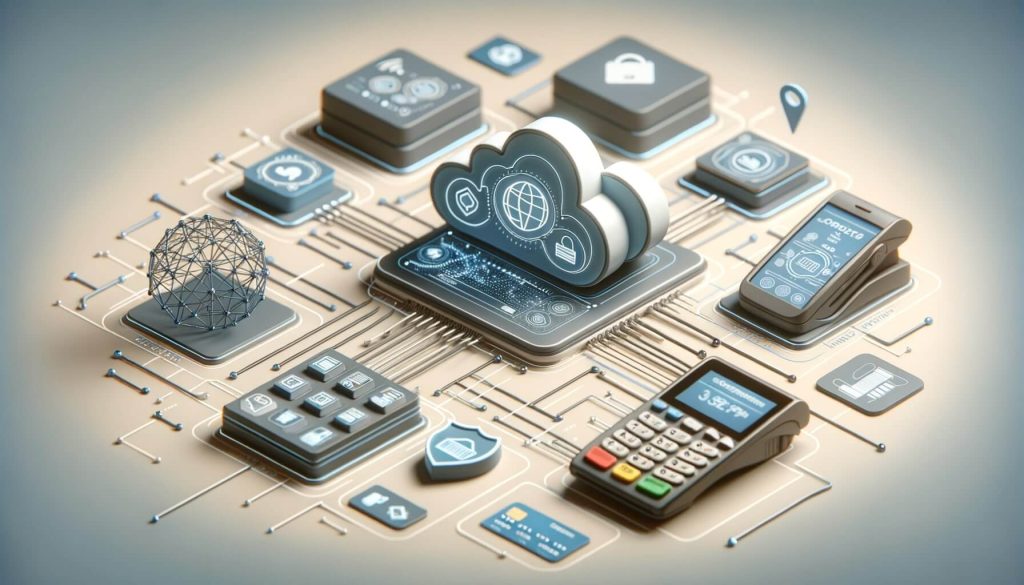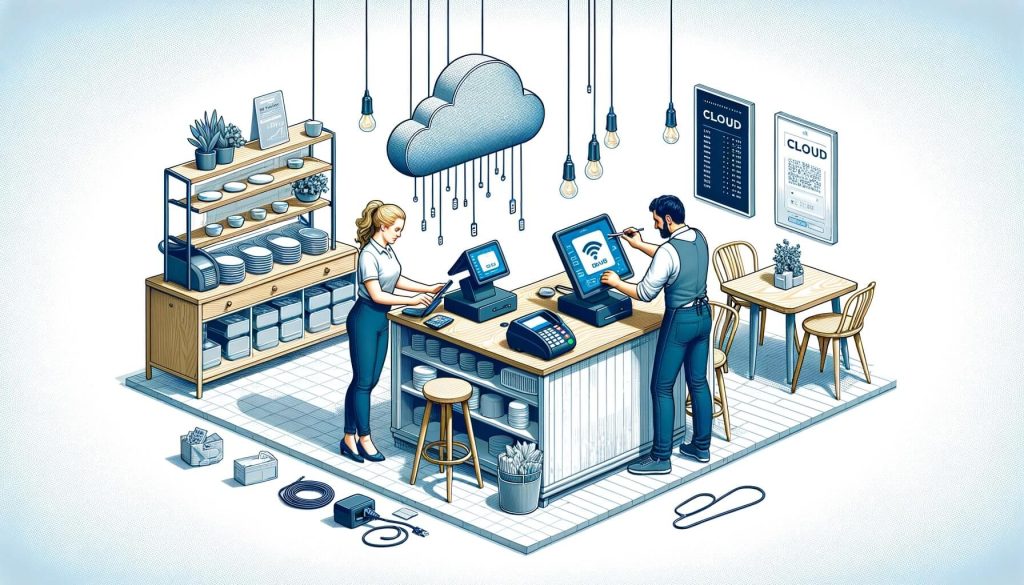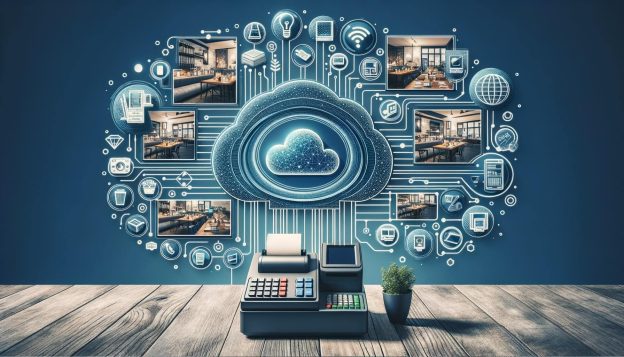In today’s fast-paced and technology-driven world, the restaurant industry is constantly evolving to meet the demands of customers. One of the most significant advancements in recent years is the adoption of cloud-based point of sale (POS) systems. These systems have revolutionized the way restaurants operate by providing a more efficient and streamlined approach to managing orders, inventory, and customer data.
In this article, we will explore the various aspects of cloud POS systems in restaurants, including their benefits, key features, factors to consider when choosing a system, setup and installation process, integration with other technologies, best practices, common challenges, and frequently asked questions.
Benefits of Implementing a Cloud POS System

Implementing a cloud POS system in a restaurant offers numerous benefits that can significantly improve operations and enhance the overall customer experience. Firstly, cloud POS systems provide real-time data access, allowing restaurant owners and managers to monitor sales, inventory, and employee performance from anywhere, at any time. This accessibility enables them to make informed decisions and take immediate action to address any issues that may arise.
Secondly, cloud POS systems offer enhanced security measures compared to traditional on-premise systems. With data stored in the cloud, restaurants are less vulnerable to data loss or theft due to hardware malfunctions or physical damage. Additionally, cloud-based systems often employ advanced encryption and authentication protocols to protect sensitive customer information, ensuring compliance with data protection regulations.
Another significant advantage of cloud POS systems is their scalability. As restaurants grow and expand, they can easily add new locations or terminals to their system without the need for extensive hardware upgrades. This scalability allows restaurants to adapt to changing business needs and accommodate increased customer demand seamlessly.
Furthermore, cloud POS systems offer seamless integration with other restaurant technologies, such as online ordering platforms, loyalty programs, and kitchen display systems. This integration streamlines operations, reduces manual errors, and improves overall efficiency. For example, when a customer places an order online, it is automatically synced with the POS system, eliminating the need for manual data entry and reducing the risk of order errors.
Key Features and Functionality of Cloud POS Systems

Cloud POS systems come equipped with a wide range of features and functionalities designed to streamline restaurant operations and enhance the customer experience. Some of the key features include:
1. Order Management: Cloud POS systems allow restaurants to efficiently manage orders, including tableside ordering, split checks, and order modifications. These systems also enable seamless communication between the front-of-house and back-of-house staff, ensuring accurate and timely order preparation.
2. Inventory Management: With cloud POS systems, restaurants can easily track and manage inventory levels in real-time. This feature helps prevent stockouts, reduces waste, and enables automatic reordering when inventory reaches a specified threshold. Additionally, inventory reports provide valuable insights into popular menu items and ingredient usage, aiding in menu planning and cost control.
3. Reporting and Analytics: Cloud POS systems generate comprehensive reports and analytics that provide valuable insights into sales trends, customer preferences, and employee performance. These reports help restaurant owners and managers make data-driven decisions to optimize operations, improve profitability, and enhance the overall dining experience.
4. Customer Relationship Management (CRM): Cloud POS systems enable restaurants to build and maintain strong customer relationships by capturing and analyzing customer data. This data can include contact information, order history, and preferences, allowing restaurants to personalize marketing campaigns, offer targeted promotions, and provide exceptional customer service.
5. Employee Management: Cloud POS systems simplify employee management tasks, such as scheduling, time tracking, and performance evaluation. These systems also enable staff to clock in and out using their unique login credentials, ensuring accurate payroll processing and reducing the risk of time theft.
Factors to Consider When Choosing a Cloud POS System for Restaurants

When selecting a cloud POS system for a restaurant, several factors should be taken into consideration to ensure the system meets the specific needs of the business. These factors include:
1. Cost: The cost of implementing a cloud POS system can vary significantly depending on the features and functionalities required. It is essential to consider both upfront costs, such as hardware and software licenses, as well as ongoing fees, such as monthly subscriptions and transaction fees. It is also important to evaluate the return on investment (ROI) and potential cost savings that the system can provide in terms of increased efficiency and reduced operational costs.
2. Scalability: Restaurants should choose a cloud POS system that can scale with their business. The system should be able to accommodate additional locations, terminals, and users as the restaurant expands. It is crucial to consider the system’s ability to handle increased transaction volumes and support future growth without compromising performance.
3. Integration Capabilities: Integration with other restaurant technologies is vital for seamless operations. The chosen cloud POS system should have the ability to integrate with online ordering platforms, loyalty programs, accounting software, and other relevant systems. This integration eliminates the need for manual data entry, reduces errors, and improves overall efficiency.
4. User-Friendliness: The ease of use of a cloud POS system is crucial for efficient operations. The system should have an intuitive interface that is easy to navigate, reducing the learning curve for staff members. Additionally, the system should offer comprehensive training and ongoing support to ensure a smooth transition and optimal utilization of its features.
5. Security and Compliance: Data security is of utmost importance when selecting a cloud POS system. The system should employ robust security measures, such as encryption and authentication protocols, to protect sensitive customer information. It is also essential to ensure that the system complies with relevant data protection regulations, such as the General Data Protection Regulation (GDPR) or the Payment Card Industry Data Security Standard (PCI DSS).
How to Set Up and Install a Cloud POS System in a Restaurant

Setting up and installing a cloud POS system in a restaurant requires careful planning and execution to ensure a smooth transition and minimal disruption to operations. The following steps outline the general process:
1. Assess Business Needs: Before selecting a cloud POS system, it is essential to assess the specific needs of the restaurant. This includes evaluating the number of locations, terminals, and users that will be supported by the system, as well as the desired features and functionalities.
2. Choose a Provider: Research and select a reputable cloud POS system provider that offers the features and functionalities required by the restaurant. Consider factors such as cost, scalability, integration capabilities, user-friendliness, and security.
3. Hardware and Software Setup: Once a provider is chosen, the next step is to set up the necessary hardware and software components. This may include purchasing compatible tablets or terminals, installing the POS software, and configuring the system to meet the restaurant’s specific requirements.
4. Data Migration: If the restaurant is transitioning from an existing POS system, data migration is necessary to ensure a seamless transfer of customer and inventory information. The chosen cloud POS system provider should offer guidance and support throughout this process to minimize data loss or errors.
5. Staff Training: Proper training is crucial to ensure that staff members are proficient in using the new cloud POS system. The provider should offer comprehensive training materials, tutorials, and ongoing support to familiarize staff with the system’s features and functionalities.
6. Testing and Troubleshooting: Before fully implementing the cloud POS system, it is important to conduct thorough testing to identify and resolve any issues or bugs. This includes testing various scenarios, such as order processing, inventory management, and reporting, to ensure the system functions as intended.
7. Go-Live and Support: Once testing is complete, the cloud POS system can be officially launched in the restaurant. The provider should offer ongoing support to address any questions or concerns that may arise and ensure the system operates smoothly.
Integrating Cloud POS Systems with Other Restaurant Technologies
Integrating a cloud POS system with other restaurant technologies is essential for streamlining operations, reducing manual errors, and improving overall efficiency. The following are some common integrations that can enhance the functionality of a cloud POS system:
1. Online Ordering Platforms: Integrating the cloud POS system with online ordering platforms, such as a restaurant’s website or mobile app, allows for seamless order processing. When a customer places an order online, it is automatically synced with the POS system, eliminating the need for manual data entry and reducing the risk of order errors. This integration also enables real-time inventory updates and provides valuable data on customer preferences and ordering patterns.
2. Loyalty Programs: Integrating the cloud POS system with a loyalty program allows restaurants to reward and incentivize customers for their repeat business. When a customer makes a purchase, their loyalty points or rewards are automatically updated in the POS system, ensuring a seamless and personalized experience. This integration also enables targeted marketing campaigns based on customer preferences and purchase history.
3. Kitchen Display Systems: Integrating the cloud POS system with a kitchen display system (KDS) improves order accuracy and expedites order preparation. When an order is placed, it is automatically sent to the KDS, eliminating the need for manual communication between the front-of-house and back-of-house staff. This integration reduces errors, enhances communication, and improves overall kitchen efficiency.
4. Accounting Software: Integrating the cloud POS system with accounting software simplifies financial management and reporting. Sales data from the POS system can be automatically synced with the accounting software, eliminating the need for manual data entry and reducing the risk of errors. This integration streamlines financial processes, such as revenue reconciliation, tax reporting, and payroll processing.
Best Practices for Using Cloud POS Systems in Restaurants
To maximize the benefits of a cloud POS system, restaurants should follow best practices to ensure optimal utilization and efficiency. The following are some key best practices:
1. Regularly Update and Maintain the System: It is important to keep the cloud POS system up to date by installing software updates and patches as they become available. These updates often include bug fixes, security enhancements, and new features that can improve system performance and functionality. Regular maintenance and monitoring of the system are also essential to identify and address any issues promptly.
2. Train Staff Effectively: Proper training is crucial to ensure that staff members are proficient in using the cloud POS system. The provider should offer comprehensive training materials, tutorials, and ongoing support to familiarize staff with the system’s features and functionalities. Regular refresher training sessions can also help reinforce knowledge and address any questions or concerns that may arise.
3. Utilize Reporting and Analytics: Take full advantage of the reporting and analytics capabilities of the cloud POS system. Regularly review sales trends, customer preferences, and employee performance reports to make data-driven decisions and identify areas for improvement. These insights can help optimize menu offerings, streamline operations, and enhance the overall dining experience.
4. Implement Robust Security Measures: Data security should be a top priority when using a cloud POS system. Implement robust security measures, such as strong passwords, encryption, and authentication protocols, to protect sensitive customer information. Regularly review and update security settings to ensure compliance with data protection regulations and industry best practices.
5. Foster a Culture of Continuous Improvement: Encourage feedback from staff members and customers to identify areas for improvement. Regularly evaluate the system’s performance, gather insights from staff and customers, and implement necessary changes or enhancements. This continuous improvement mindset ensures that the cloud POS system remains aligned with the evolving needs of the restaurant and its customers.
Common Challenges and Solutions in Implementing Cloud POS Systems
While implementing a cloud POS system in a restaurant offers numerous benefits, there can be challenges along the way. Understanding these challenges and implementing appropriate solutions can help ensure a successful implementation. Some common challenges and their solutions include:
1. Connectivity Issues: Cloud POS systems rely on a stable internet connection to function properly. In areas with unreliable or slow internet connectivity, restaurants may experience disruptions in service. To mitigate this challenge, restaurants can consider implementing backup internet connections, such as a secondary internet service provider or a mobile hotspot, to ensure uninterrupted operations.
2. Staff Resistance to Change: Introducing a new cloud POS system may be met with resistance from staff members who are accustomed to traditional systems. To overcome this challenge, it is crucial to provide comprehensive training and ongoing support to familiarize staff with the new system’s features and functionalities. Engage staff in the decision-making process and highlight the benefits of the cloud POS system to gain their buy-in and cooperation.
3. Data Migration and Integration Issues: When transitioning from an existing POS system, data migration and integration can be complex and time-consuming. To address this challenge, work closely with the chosen cloud POS system provider to ensure a seamless transfer of customer and inventory data. Conduct thorough testing to identify and resolve any integration issues before fully implementing the system.
4. System Downtime and Technical Support: Despite robust infrastructure and maintenance, cloud POS systems may experience occasional downtime or technical issues. To minimize the impact of system downtime, choose a provider that offers reliable technical support and has a proven track record of uptime. Implement backup procedures, such as manual order taking or offline mode, to ensure uninterrupted operations during system downtime.
Frequently Asked Questions
Q1. What is a cloud POS system?
A cloud POS system is a point of sale system that operates on cloud-based servers rather than traditional on-premise servers. It allows restaurants to manage orders, inventory, and customer data in real-time from anywhere, at any time.
Q2. How does a cloud POS system benefit restaurants?
Cloud POS systems offer numerous benefits, including real-time data access, enhanced security, scalability, seamless integration with other technologies, and improved operational efficiency.
Q3. What factors should restaurants consider when choosing a cloud POS system?
Restaurants should consider factors such as cost, scalability, integration capabilities, user-friendliness, and security when choosing a cloud POS system.
Q4. How is a cloud POS system set up and installed in a restaurant?
Setting up and installing a cloud POS system involves assessing business needs, choosing a provider, setting up hardware and software, migrating data, training staff, testing the system, and launching it in the restaurant.
Q5. How can a cloud POS system be integrated with other restaurant technologies?
Cloud POS systems can be integrated with online ordering platforms, loyalty programs, kitchen display systems, and accounting software to streamline operations and improve efficiency.
Conclusion
Cloud POS systems have revolutionized the way restaurants operate by providing real-time data access, enhanced security, scalability, and seamless integration with other technologies. By carefully considering factors such as cost, scalability, integration capabilities, user-friendliness, and security, restaurants can choose a cloud POS system that meets their specific needs.
Proper setup, installation, and integration, along with staff training and ongoing support, are crucial for a successful implementation. By following best practices and addressing common challenges, restaurants can maximize the benefits of a cloud POS system and enhance their overall operations and customer experience.

